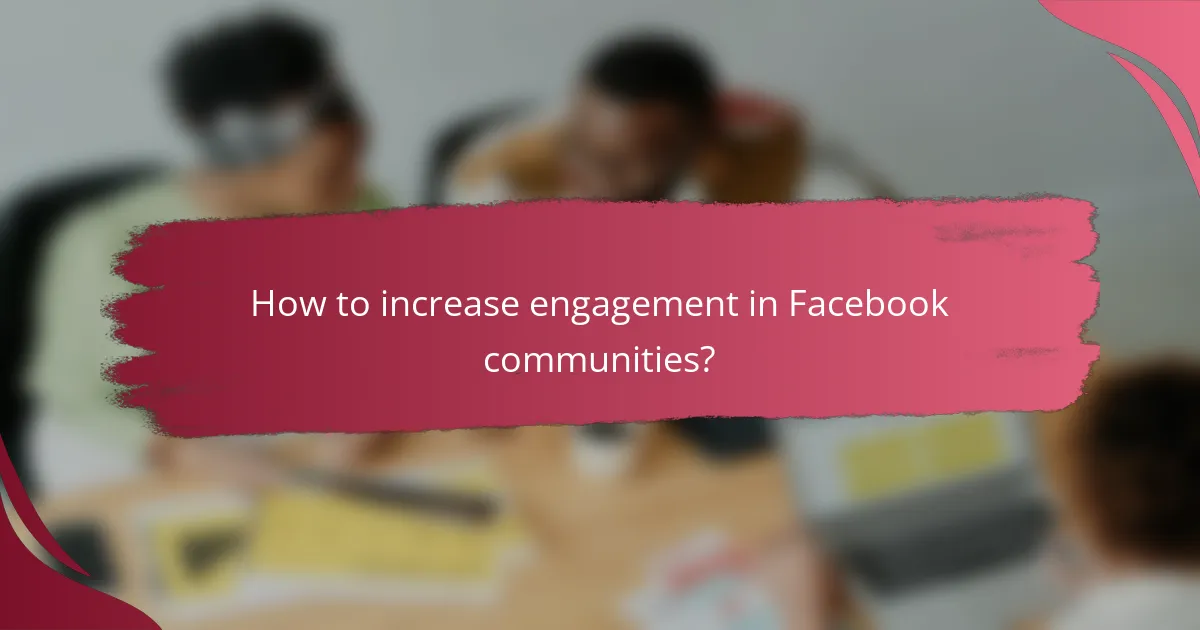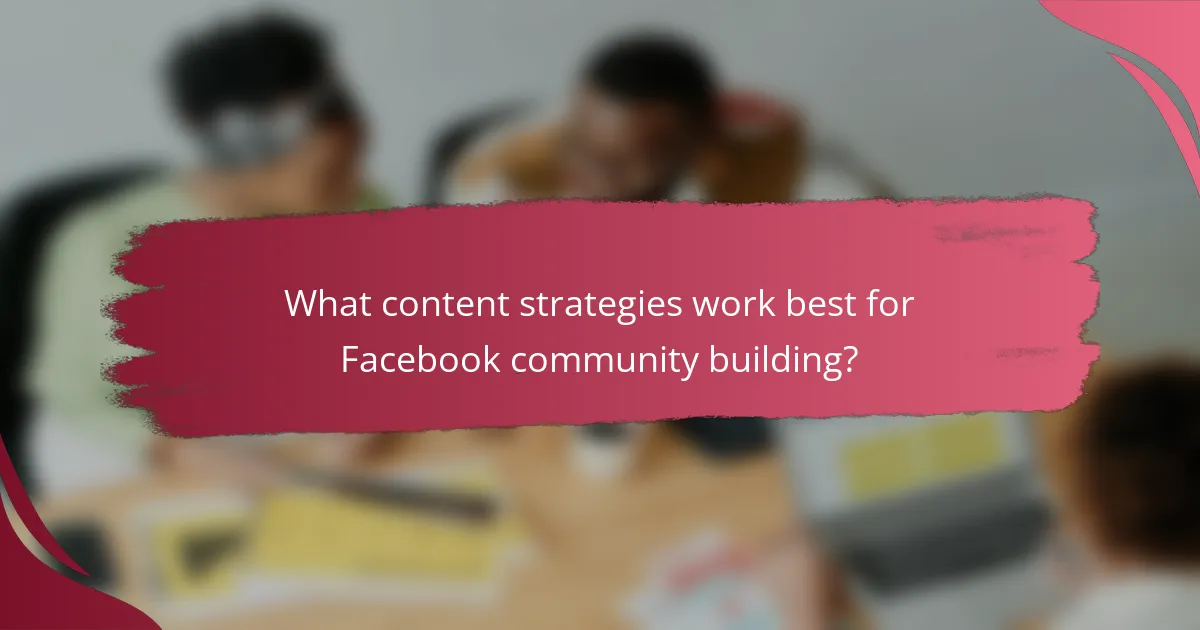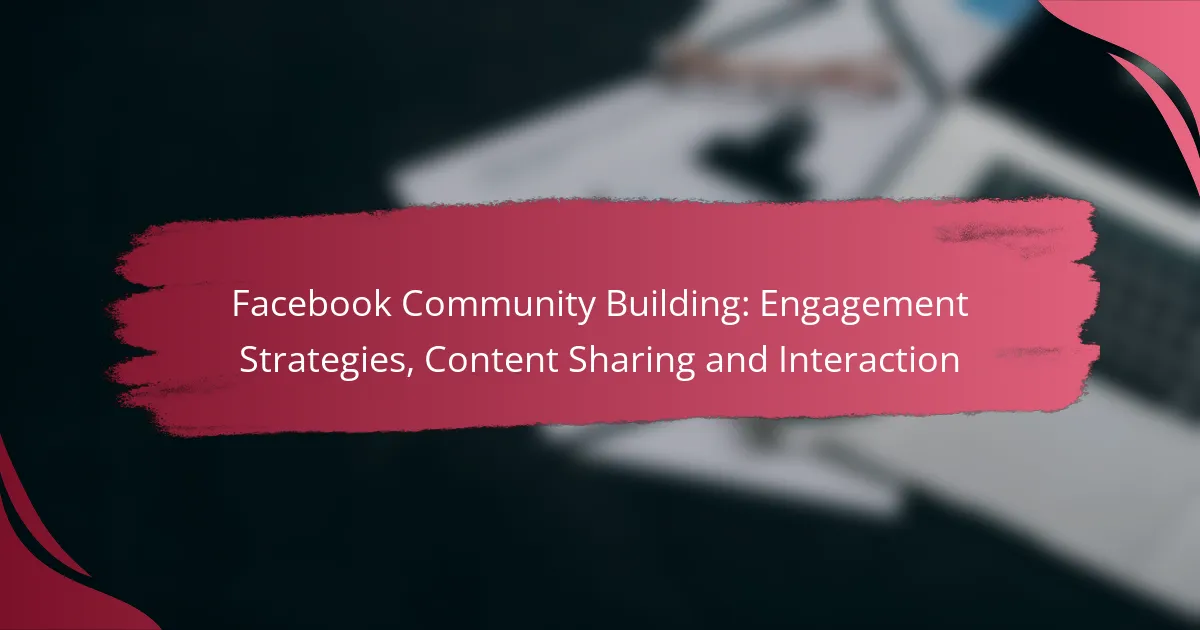Building a vibrant Facebook community requires strategic engagement and interaction among members. By creating interactive content, utilizing polls, and encouraging user-generated contributions, communities can foster a sense of belonging. Additionally, prioritizing engaging and shareable materials, such as visual content and personal stories, enhances connection and growth within the group.

How to increase engagement in Facebook communities?
To increase engagement in Facebook communities, focus on creating interactive content and fostering a sense of belonging among members. Effective strategies include utilizing polls, hosting live events, encouraging user-generated content, implementing themed posts, and recognizing active participants.
Utilize polls and questions
Polls and questions are effective tools for boosting engagement as they invite direct participation from community members. Use simple, clear questions that relate to your community’s interests to spark discussions and gather opinions.
For example, you might ask members to vote on their favorite product features or share their thoughts on a recent trend. This not only increases interaction but also provides valuable insights into member preferences.
Host live events and Q&A sessions
Live events and Q&A sessions create real-time interaction opportunities, making members feel more connected. Schedule regular sessions where community leaders or experts can address member questions and discuss relevant topics.
Consider using Facebook Live or similar tools to facilitate these events, ensuring they are promoted in advance to maximize attendance. Engaging with members during these sessions can significantly enhance their sense of community involvement.
Encourage user-generated content
Encouraging user-generated content (UGC) allows members to share their experiences and creativity, fostering a collaborative environment. Create campaigns or challenges that prompt members to post their own content related to the community’s theme.
For instance, you could ask members to share photos of their projects or testimonials about your products. Highlighting UGC not only increases engagement but also builds trust and authenticity within the community.
Implement regular themed posts
Regular themed posts provide structure and anticipation, helping to maintain consistent engagement. Establish weekly or monthly themes that encourage members to contribute their thoughts or experiences on specific topics.
Examples include “Motivation Mondays” or “Feedback Fridays,” where members can share insights or ask for advice. This routine can help keep the community active and engaged over time.
Recognize and reward active members
Recognizing and rewarding active members is crucial for maintaining engagement and encouraging participation. Acknowledge contributions publicly through shout-outs or feature posts that highlight member achievements.
Consider implementing a rewards system, such as badges or exclusive content access, to incentivize participation. This recognition can motivate others to engage more actively, creating a vibrant community atmosphere.

What content strategies work best for Facebook community building?
Effective content strategies for Facebook community building focus on creating engaging, shareable materials that resonate with your audience. Prioritizing visual content, personal stories, and interactive elements can significantly enhance community interaction and growth.
Create shareable infographics
Infographics are highly shareable due to their visual appeal and ability to convey complex information quickly. To create effective infographics, focus on clear, concise messaging and eye-catching design. Use tools like Canva or Piktochart to simplify the design process.
Consider including statistics, tips, or step-by-step guides relevant to your community’s interests. Aim for infographics that can be easily shared across platforms, increasing your reach and engagement.
Post behind-the-scenes content
Behind-the-scenes content offers a personal glimpse into your community or organization, fostering a sense of connection and authenticity. Share photos or videos of team activities, project development, or day-to-day operations to create a relatable narrative.
This type of content encourages interaction as members feel more involved and invested in your community. Regularly posting behind-the-scenes updates can strengthen relationships and boost engagement rates.
Share success stories and testimonials
Success stories and testimonials highlight the positive impact of your community, motivating others to engage. Showcase individual achievements or collective milestones to inspire and encourage participation.
When sharing testimonials, use direct quotes and personal anecdotes to enhance credibility. Consider creating a dedicated post series to regularly feature these stories, keeping your community informed and inspired.
Use video content for storytelling
Video content is a powerful tool for storytelling, allowing for emotional connections and dynamic engagement. Utilize live videos, short clips, or longer narratives to share experiences, insights, or community highlights.
Keep videos concise and focused, ideally between one to three minutes, to maintain viewer interest. Encourage community members to participate by sharing their own video stories, fostering a collaborative environment.

How to foster interaction among community members?
Fostering interaction among community members involves creating an environment where individuals feel comfortable sharing their thoughts and engaging with one another. This can be achieved through various strategies that encourage dialogue, networking, and personal connections.
Encourage comments and discussions
Encouraging comments and discussions is essential for building a vibrant community. Pose open-ended questions related to your content to stimulate conversation and invite members to share their opinions. For instance, after posting an article, ask members what they think about the topic or how it relates to their experiences.
To enhance engagement, respond to comments promptly and thoughtfully. This not only shows that you value member input but also encourages others to join the conversation. Consider highlighting particularly insightful comments to further motivate participation.
Facilitate networking opportunities
Facilitating networking opportunities helps members connect on a personal level. Organize virtual meetups or themed discussions where members can share their expertise and interests. This could be a monthly video call or a dedicated thread for introductions.
Additionally, create subgroups based on specific interests or professions within your community. This allows members to find like-minded individuals and fosters deeper connections, enhancing the overall community experience.
Use direct messaging for personal engagement
Using direct messaging is a powerful way to engage with community members on a personal level. Reach out to new members with a welcome message, inviting them to share their thoughts and experiences. This personal touch can make them feel valued and more likely to participate actively.
However, be mindful of privacy and boundaries. Ensure that your messages are respectful and relevant to their interests. Avoid spamming members with unsolicited messages, as this can lead to disengagement rather than fostering a sense of community.

What are the best practices for content sharing in Facebook groups?
Effective content sharing in Facebook groups involves posting relevant, engaging material that resonates with your community. Key practices include sharing industry news, collaborating with other groups, and establishing a regular posting schedule to keep members engaged.
Share relevant industry news
Sharing industry news keeps your group informed and positions it as a valuable resource. Focus on articles, reports, or updates that directly relate to your group’s interests. Aim for a mix of local and global news to cater to diverse member preferences.
Consider summarizing key points from articles or adding your insights to spark discussion. This not only encourages interaction but also enhances the perceived value of the content shared.
Cross-promote with other communities
Cross-promotion with other Facebook groups can expand your reach and introduce new members. Identify groups with similar interests or complementary themes and propose content exchanges or joint events.
When collaborating, ensure that both communities benefit. This could involve guest posts, shared live sessions, or co-hosted challenges. Always respect group rules and maintain a focus on providing value to both audiences.
Maintain a consistent posting schedule
A consistent posting schedule helps establish expectations and keeps members engaged. Determine a frequency that works for your group, whether it’s daily, weekly, or bi-weekly, and stick to it.
Utilize tools like scheduling software to plan posts in advance. This allows for a balanced mix of content types, such as polls, questions, and articles, ensuring that members remain interested and active in discussions.

What metrics should be tracked for community success?
To gauge community success on Facebook, focus on metrics like engagement rates, member growth, and retention. These indicators provide insights into how well your community is connecting with its members and sustaining interest over time.
Measure engagement rates
Engagement rates reflect how actively members interact with your content. This includes likes, comments, shares, and reactions. A healthy engagement rate typically ranges from 1% to 5%, depending on your community size and content type.
To effectively measure engagement, track the number of interactions relative to total members or post reach. Tools like Facebook Insights can help you analyze these metrics over time, allowing you to adjust your content strategy accordingly.
Consider experimenting with different content formats, such as polls, videos, or live sessions, to see what resonates most with your audience. Regularly reviewing engagement metrics will help you identify trends and optimize your approach.
Track member growth and retention
Monitoring member growth and retention is crucial for understanding the health of your community. Growth can be measured by the number of new members joining over a specific period, while retention focuses on how many members remain active over time.
Set benchmarks for growth, such as aiming for a 10% increase in membership each month. Retention rates can be improved by fostering a welcoming environment and regularly engaging with members through updates and discussions.
Utilize Facebook’s analytics tools to track these metrics and identify patterns. If you notice a drop in retention, consider conducting surveys to understand member satisfaction and areas for improvement.
